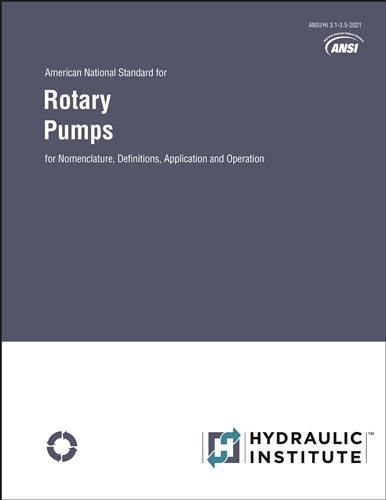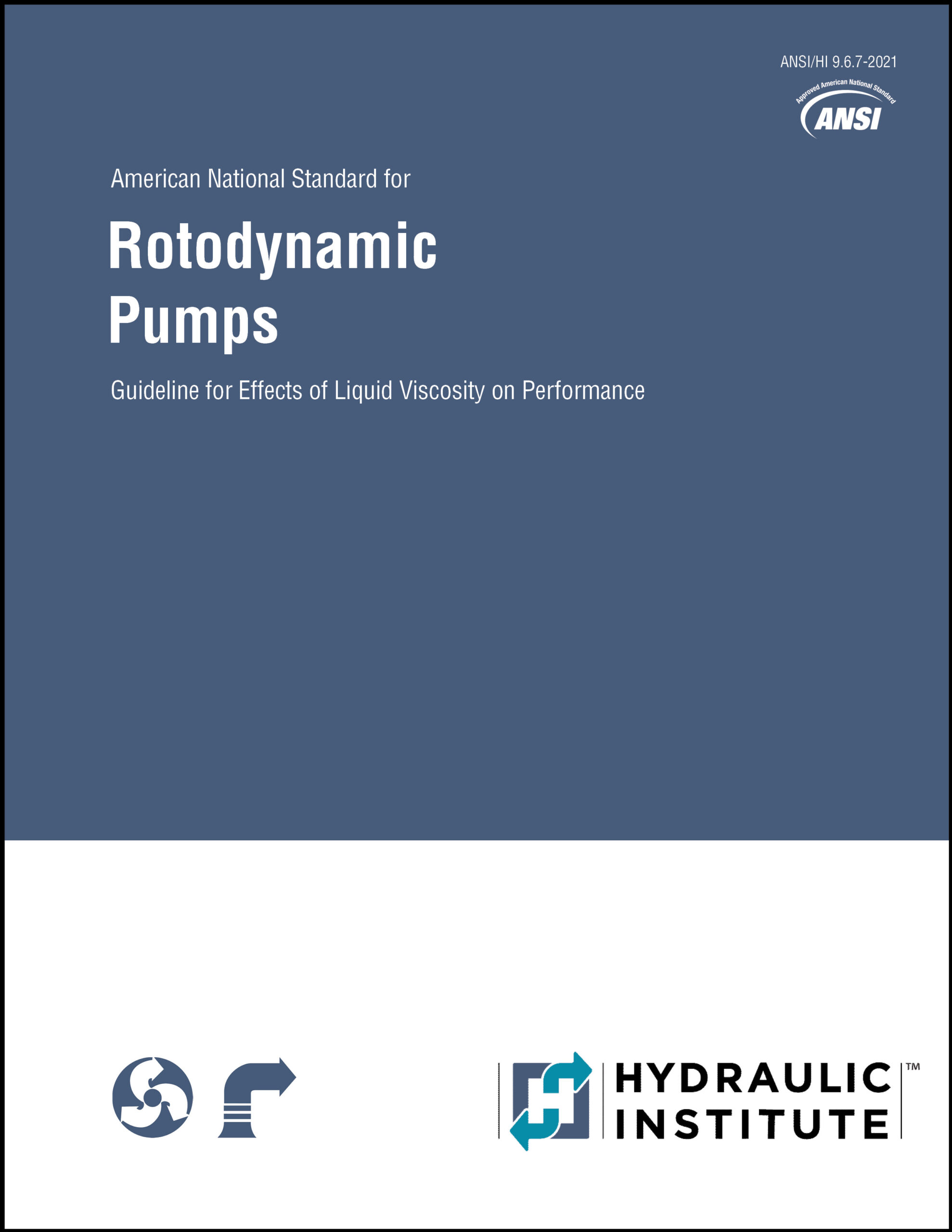Viscosity
Definitions and Methods of Measurement
The viscosity of a fluid (liquid or gas) is that property which tends to resist a shearing force. Since motion or flow of a fluid is produced by shearing forces, viscosity is associated with fluid motion. There is no relation between the viscosity and the specific gravity of most liquids. For instance, molasses having the same specific gravity (1.48) and the same Brix rating (90) may vary in viscosity from 128,000 to 303,000 Seconds Saybolt Universal (SSU). In rotodynamic pumps, fluid viscosity can have a significant impact on performance. ANSI/HI 9.6.7 acts as a guideline that explains these effects.
There are two basic viscosity parameters: dynamic (or absolute) viscosity and kinematic viscosity. (See the Kinematic and Dynamic Viscosity Conversion Tool to perform viscosity conversions.) The dynamic viscosity may be defined with the aid of Fig. 2.C.1 which shows two parallel plane surfaces of area (A) separated a distance (d) and the space between completely filled with fluid. A force (F) is applied to and in the plane of the upper surface, causing it to move with a velocity (v) parallel to the lower fixed surface. The velocity distribution will be linear over the distance (d) and experiments show that the slope of the velocity line (v/d) will be directly proportional to the unit shearing force (τ = F/A) for all "true" or "Newtonian" fluids. The proportionality factor (μ) is the dynamic viscosity. The foregoing may be expressed by the equations
(Eq. 2.C.1)
(Eq. 2.C.2)
Therefore, the dimensions of the dynamic viscosity are
The unit of dynamic viscosity in English measure is the pound-second per square foot which is numerically identical with the slug per foot-second.

The kinematic viscosity (𝜈) may be obtained by dividing the dynamic viscosity (μ) by the mass density (ρ). The mass density is the specific weight (w) divided by the acceleration of gravity (g). These relationships may be expressed by the equation
(Eq. 2.C.3)
Therefore, the dimensions of kinematic viscosity are
The unit of kinematic viscosity in English measure is the square foot per second.
The distinction between the dynamic and the kinematic viscosity should be carefully noted so that the correct parameter will be used as required in computations. Some useful relationships are as follows:
1 pound = 444,823 dynes
1 foot = 30.4800 centimeters
1 square foot = 929.034 square centimeters
1 dyne-second per sq cm = 1 poise = 100 centipoise
1 sq cm/sec = 1 stoke = 100 centistokes
1 lb-sec/sq ft = 478.801 poises = 47,880.1 centipoise
μ lb-sec/sq ft = (μ/47,880.1)centipoise = 0.0000208855 centipoise
𝜈 sq ft/sec = 𝜈 sq cm/sec / 929.034 = 0.00107639 stokes
𝜈 = μ/ρ = μ/(w/g)
𝜈 sq ft/sec = 0.000671970(μ/w)
where:
- w = lbf/cu ft
- g = 32.17 ft/s2 at sea level and approximately 45 degrees latitude

Rotary Pumps for Nomenclature, Definitions, Application, and Operation
This standard offers a basic educational overview on rotary pumps, design and application considerations related to the selection of the right rotary pump for a specific industry use as well as the installation, maintenance and operating procedures.
The viscosities of most fluids vary appreciably with changes in temperature. The influence of change in pressure usually is negligible.
The viscosities of fluids, such as mineral oil and water, are unaffected by the magnitude and kind of motion to which they may be subjected as long as the temperature remains constant. Thus, the ratio of shear stress to shear rate is a constant for all shear rates, is independent of time, and zero shear rate exists only at zero shear stress; such a fluid is said to be Newtonian.
When the ratio of shear stress to shear rate increases as the shear rate increases, reversibly and independent of time, a fluid is said to be dilatant.
When the shear stress to shear rate ratio is constant for shear rates above zero, is independent of time, but when shear occurs only for shear stress above a fixed minimum greater than zero, a fluid is said to be plastic.
When the ratio of shear stress to shear rate decreases as shear rate increases, reversibly and independent of time, and zero shear rate occurs only at zero shear stress, a fluid is said to be pseudo-plastic.
When the ratio of shear stress to shear rate decreases as shear rate increases and is time dependent in that this ratio increases back to its "rest" value gradually with lapse of time at zero shear rate and stress and decreases to a limit value gradually with lapse of time at constant shear rate, a fluid is said to be thixotropic.
When the shear stress to shear ratio rate is constant for all shear rates at any given instant of time, but increases with time, a fluid is said to be rheopectic.
Viscosity is measured by an instrument called a viscosimeter. A definite volume of fluid is allowed to flow through a capillary tube or orifice of specified proportions and the time of efflux noted. Instruments of the capillary type, such as the Ostwald, Bingham, and Ubbelohde viscosimeters are used primarily for fluids of low viscosity, such as water. Instruments of the orifice type are used commercially for more viscous fluids such as petroleum products, and the time of efflux of the sample is taken as a measure of the viscosity. The Saybolt viscosimeter is commonly used in the United States, the Saybolt Universal for fluids of medium viscosity and the Saybolt Furol for those of high viscosity. The viscosity is expressed in Seconds Saybolt Universal (SSU) or Seconds Saybolt Furol (SSF). The relationship between Saybolt Universal viscosities and kinematic viscosities in centistokes is given in "ASTM Conversion Tables for Kinematic and Saybolt Universal Viscosities" or by the ASTM Standard, Designation: D446-85a*.
Similar information for Saybolt Furol viscosities may be obtained from the ASTM Standard, Designation: D2161-87. The respective British counterparts of the Saybolt Universal and Saybolt Furol viscosimeters are the Redwood and Redwood Admiralty viscosimeters. The Engler viscosimeter is used extensively on the continent of Europe. Viscosimeters such as the Brookfield are particularly useful with non-Newtonian fluids. There are many other viscosimeters for special purposes, discussion of which is beyond the scope of this Manual.
*American Society for Testing Materials, 1916 Race St., Philadelphia. Pa. 19103.
Viscosity conversion tables for use with the above described viscosimeters are in tables 2.C.1, 2.C.2 and 2.C.3. A viscosity blending chart for use with oils is also provided in Fig. 2.C.2. To use this blending chart let oil (A) have the higher viscosity and oil (B) the lower viscosity. Mark the viscosity of (A) and (B) on the right and left hand scales, respectively, and draw a straight line connecting the marks as shown. The viscosity of any blend of (A) and (B) will be shown by the intersection of the vertical line representing the percentage composition and the line described above.
Viscosity Blending Chart [1]


ANSI/HI 9.6.7 Rotodynamic Pumps Guideline for Effects of Liquid Viscosity on Performance
Learn the calculation methods to adjust the tested flow, head, efficiency and power on water to the viscosity the pump will be handling. Additionally, learn how NPSHR will be affected and considerations for starting torque.
Viscosity Conversion Tables
The following tables will give an approximate comparison of various viscosity ratings so that if the viscosity is given in terms other than Saybolt Universal, it can be translated quickly by following horizontally to the Saybolt Universal column.
Conversions
Note: These values of SSU are at 100 °F.
When the Metric System terms centistokes and centipoise are used, the density is numerically equal to the specific gravity. Therefore, the following expression can be used which will be sufficiently accurate for most calculations:
(Eq. 2.C.4)
When the English System units are used, the density must be used rather than the specific gravity.
(Eq. 2.C.5)
For values of 70 centistokes and above, use the following conversion, otherwise use the table Tbl 2.C.2:
(Eq. 2.C.6)
A programmable, smooth function is provided in ANSI/HI 9.6.7 to convert centistokes to Seconds Saybolt Universal.
Above the range of this table and within the range of the viscosimeter, multiply the particular value by the following approximate factors to convert to SSU:
Conversion Factors
| Viscosimeter | Factor |
|---|---|
| Saybolt Furol | 10 |
| Redwood Standard | 1.095 |
| Redwood Admiralty | 10.87 |
| Engler-Degrees | 34.5 |
| Parlin cup #15 | 98.2 |
| Parlin cup #20 | 187 |
| Ford cup #4 | 17.4 |
| Mac Michael | 1.92 (approx.) |
| Demmler #1 | 14.6 |
| Demmler #10 | 146 |
| Stormer | 13 (approx.) |
References
- Hydraulic Institute, Engineering Data Book, Second Edition, 1990, Figure IIC-2.
Last updated on July 19th, 2024